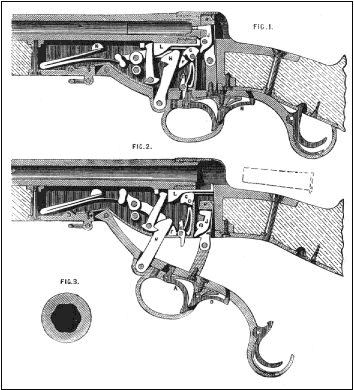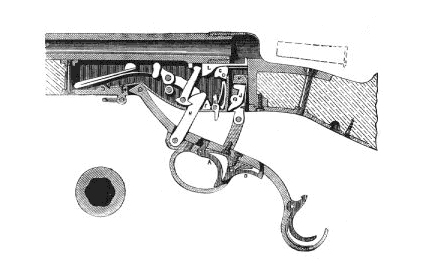You are here: Home > Firearms > Gunmakers > William Soper
Source: The Engineer, 13 December 1867

The rifle invented by Mr. W. Soper, of Reading, and illustrated in Figs. 1 and 2, was one of the number sent for the recent competition at Woolwich, and was rejected on the ground of “complication of breech arrangement.” In this rifle the breech-piece is formed of a block of steel R, working freely up and down in a vertical slot at the rear of the barrel, and secured to a lever fixed at the bottom of the lock, which is placed in the center of the stock. The striker J is mounted inside the breech-piece, and works easily without any spring. The cock is also secured to the breech lever in such a manner that the breech-piece and cock are worked simultaneously.
The attachment is effected by the swivel H, furnished with a projection and recess for working the extractor L, so that the one movement of drawing down the lever opens the breech, cocks the piece, and throws out the cartridge case. The trigger A is mounted on the lever, and has no connection with the sear E until the breech is placed home, and thus the rifle cannot be fired until the safety catch B is pressed. For cleaning purposes the lock and breech-piece can be removed by withdrawing a couple of screws. Fig. 3 shows a section of the rifling, the calibre being that of the service rifle.
The trials of this rifle at Woolwich were satisfactory. For rapidity twelve rounds were fired in thirty-nine seconds with three mis-fires; the mean deviation of eight shots fired for accuracy from a shoulder rest at 500 yards, with Boxer cartridges, No. 3 pattern, was 2.30ft. Many excellent results have also since been obtained. Nevertheless we cannot but agree with the committee that the mechanism of the breech and lock is too complicated for a purely military weapon, and, moreover, that they were perfectly correct in doubting the value of the safety catch as a substitute of the ordinary half-cock. Mr. Soper has expended a great deal of ingenuity, and has produced a weapon which gives good results, but we think it cannot be denied that it is unsuitable for the use of the soldier.
